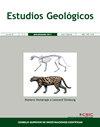Registro fósil y distribución de Anadenathera en Argentina desde el Mioceno hasta la actualidad
IF 0.8
4区 地球科学
Q3 GEOLOGY
引用次数: 1
Abstract
Currently Fabaceae, is one of the dominant families of the Seasonally Dry Tropical Forests or Neotropical seasonal dry forests. Anadenanthera which integrates the family, has wide geographical distribution in South America and the West Indies, but in Argentina it`s only present Anadenantera colubrina var. cebil in the north and their records are represented from the Miocene to the present through palynomorphs and mineralized woods. The main objective of this work is to contribute to the understanding in the context of the history of Anadenanthera during the Neogene and Quaternary in Argentina, on the basis of the review and integration of the paleobotanical history, geological and climatic available that have affected the genre in the country. Studied fossil materials come from different geological formations of Argentina: Chenque Formation (Miocene), Parana Formation (Middle Miocene), San Jose Formation (Middle Miocene), Ituzaingo Formation (Pliocene) and Ibera (Holocene). The material found on the Chenque Formation is referred to Polyadopollenites coincides with the described material for the Middle Miocene of the central-eastern Argentina and the Pliocene of northeast Argentina. On the other hand in Parana and Ituzaingo Formation studied sample of mineralized woods of Anadenantheroxylon villaurquisense , finally the sample found in Holocene of Ibera Corrientes Province corresponds to Anadenanthera colubrina var. macrocarpa . With these data it can be concluded that Anadenathera had a wide geographical record in Miocene and Holocene of Argentina, it was found in sediments from the lower Miocene of Patagonia by integrating a Subtropical Paleoflora. From the Middle-Upper Miocene integrated the vegetation in northeast Argentine constituting xerophiles forests. Their last record is equivalent to the Middle Holocene of sediments from Ibera integrating the regional vegetation and indicating an open vegetation characteristics of dry environments. Finally it`s noteworthy that the spatial and temporal succession of Anadenanthera in Argentina, would have been intimately associated with tectonic and climatic events occurred during the Neogene and Quaternary.阿根廷Anadenathera中新世至今的化石记录及分布
豆科植物是热带季节性干燥林或新热带季节性干燥林的优势科之一。整合科的Anadenanthera在南美洲和西印度群岛有广泛的地理分布,但在阿根廷只存在于北部的Anadenantera colubrina var. cebil,它们的记录从中新世到现在,通过形态和矿化森林表现出来。本研究的主要目的是通过对阿根廷影响该类型的古植物学历史、地质和气候资料的回顾和整合,对阿根廷新近纪和第四纪Anadenanthera的历史背景进行了解。研究的化石材料来自阿根廷不同的地质构造:中新世Chenque组、中中新世Parana组、中中新世San Jose组、上新世Ituzaingo组和全新世Ibera。在Chenque组发现的材料被称为多adopolenites,与阿根廷中东部中新世和阿根廷东北部上新世的材料一致。另一方面,在Parana组和Ituzaingo组研究了Anadenantheroxylon villaurquisense的矿化木材样品,最终在Ibera Corrientes省全新世发现的样品与Anadenanthera colubrina var. macrocarpa相对应。由此可以得出结论,Anadenathera在阿根廷中新世和全新世有广泛的地理记录,它是通过整合亚热带古植物群在巴塔哥尼亚中新世下的沉积物中发现的。中新世中上段开始,阿根廷东北部的植被整合形成了嗜干森林。他们的最后记录相当于中全新世伊比利亚的沉积物,整合了区域植被,表明干旱环境下的开放植被特征。最后,值得注意的是,阿根廷Anadenanthera的时空演替可能与新近纪和第四纪的构造和气候事件密切相关。
本文章由计算机程序翻译,如有差异,请以英文原文为准。
求助全文
约1分钟内获得全文
求助全文
来源期刊

Estudios Geologicos-Madrid
GEOLOGY-
CiteScore
1.40
自引率
14.30%
发文量
6
审稿时长
>12 weeks
期刊介绍:
Since 1945 Estudios Geologicos publishes original research works, as well as reviews, about any topic on Earth Sciences.
Estudios Geologicos is published as one yearly volume, divided into two half-yearly issues. It is edited by the Spanish National Research Council (Consejo Superior de Investigaciones Científicas, CSIC) at the Instituto de Geociencias (CSIC-UCM).
Estudios Geologicos provides free access to full-text articles through this electronic edition. Accepted articles appear online as "Forthcoming articles" as soon as the galley proofs have been approved by the authors and the Editor-in-Chief. No changes can be made after online publication.
 求助内容:
求助内容: 应助结果提醒方式:
应助结果提醒方式:


